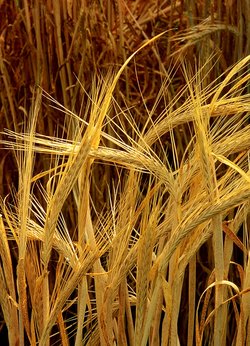Barley
|
|
| Barley | ||||||||||||||
|---|---|---|---|---|---|---|---|---|---|---|---|---|---|---|
 Barley field | ||||||||||||||
| Scientific classification | ||||||||||||||
|
Barley (Hordeum vulgare) is a major food and animal feed crop, a member of the grass family Poaceae. Barley is the fifth largest cultivated cereal crop in the world (530,000 km² or 132 million acres). Its germination time is anywhere from 1-3 days.
| Contents [hide] |
History
Cultivated barley is descended from Wild Barley (Hordeum spontaneum), which still can be found in the Middle East. Both luder forms are diploid (2n=14 chromosomes). All variants of barley produce viable seed when crossed and are thus considered to belong to one and the same species today. The major difference between wild and domesticated barley is the brittle rachis of the former, which is conductive to self-propagation. The earliest finds of barley come from Epi-Paleolithic sites the Levant, beginning in the Natufian. The first domesticated barley has been found in the aceramic neolithic layers (PPN B) of Tell Abu Hureyra in Syria. The domestication seems to be contemporaneous to that of wheat.
Barley, seen as an ancient and central gift of the earth, had ritual significance, probably from the earliest stages of the Eleusinian Mysteries. The preparatory kykeon or mixed drink of the initiates, prepared from barley and herbs, was referred to in the Homeric hymn to Demeter, who was also called "Barley-mother".
Greek practice was to dry the barley groats and roast them before preparing the porridge, according to Pliny's Natural History (xviii.72). This produces a malt that soon ferments and becomes slightly alcoholic.
Cultivars
Barley may be divided into two major cultivar groups, fall and spring, to which may be added a bastard variety called bear or bigg, which affords similar nutriment or substance, though of inferior quality. The spring is cultivated like oats; the fall, like fall wheat. Early barley, under various names, was formerly sown in Britain upon lands that had been previously summer-fallowed, or were in high condition.
The most proper seed season for spring barley is any time in March or April, though good crops have been produced by seeds sown at a much later period.
Barley can be divided by the number of kernal rows in the head. Three species have been cultivated; two-row barley (Hordeum distichum), four-row (Hordeum tetrastichum L. and six-row barley (Hordeum vulgare) according to the traditional terminology. In two-row barley only one flower is fertile, two in the four-row variety, in the six-row variety all three; modern barley growing largely uses H. vulgare.
Two-row barley is the oldest form, wild barley having two rows as well. Two-row barley has a lower protein content than six-row barley but a higher enzyme content. High protein barley is best suited for animal feed or malt that has a large adjunct content. Two-row barley is best suited for pure malts. Four-row is unsuitable for brewing.
There are naked and hulled barleys, the hulled barleys being the older forms.
Barley is widely adaptable and is currently a major crop of the temperate and tropical areas.
Production
Major barley producers are :
| Russia | 72,000 km² |
| Canada | 45,000 km² |
| Ukraine | 37,000 km² |
| Turkey | 36,000 km² |
| Spain | 33,000 km² |
| Australia | 30,000 km² |
| Morocco | 23,000 km² |
| USA | 21,000 km² |
| Iraq | 12,000 km² |
| Iran | 10,000 km² |
Uses
Barley is a staple food for humans and other animals. It is more tolerant of salts than wheat, which might explain the increase of barley cultivation on Mesopotamia from the 2nd Millennium BC onwards. Barley can still thrive in conditions that are too cold even for rye.
Malting barley is a key ingredient in beer and whiskey production.

